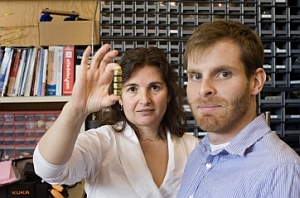Researchers at Massachusetts Institute of Technology have devised a process to enable the self-assembly of smart materials into predetermined shapes. Computer science professor Daniela Rus and grad student Kyle Gilpin from MIT’s Distributed Robotics Laboratory will discuss their findings at the IEEE International Conference on Robotics and Automation in May 2012.
The research by Rus and Gilpin focuses on giving basic, even raw, materials enough intelligence and electronic properties that can form into configurable shapes. But unlike other building-block methods that put basic components together, this process aims to start with a mass of material that can be shaped like a sculpture into the specified form.
The goal, says Rus, is to be able to configure the materials based on a model embedded in an undefined mass of material, and not store the instructions in the materials themselves. Thus, the materials need just enough smarts to respond to the shape of the embedded model, but no more than that.
Rus and Gilpin have written and tested algorithms using as raw materials 10-millimeter cubes with magnetic properties, called smart pebbles. The electropermanent magnets, as they are called, in the cubes can be switched on and off with an electric pulse, and do not need a constant current to maintain their magnetism. The smart pebbles use the magnets not only to connect to each other, but also to communicate and to share power. Each pebble also has a tiny microprocessor, which can store just 32 kilobytes of program code and has two kilobytes of working memory.
Because of physical limitations, the pebbles have magnets on only four faces. With the addition of the microprocessor and circuitry to regulate power, says Gilpin, “there just wasn’t room for two more magnets.”
The smart pebbles sense the position of the embedded model by the lack of magnetic field from their neighboring cubes; the algorithms test for positioning of a cube on the exterior of the original array of cubes, which can also indicate the lack a magnetic neighbor. Once the smart pebbles neighboring the embedded model identify themselves, they pass messages to other cubes a fixed distance away to assemble into the same shape, and based on the instructions, scaled to a specified size. Once the perimeter of the output object is defined, the smart pebbles outside the object can disconnect from their neighbors, leaving the specified object.
Rus and Gilpin say they have tested the smart pebbles on a simplified two-dimensional grid, but they say it is possible to extend the process to three-dimensional objects. Computer simulations, they report, show the process could treat each layer of the block as a two-dimensional grid. The pebbles discarded from the final shape then would disconnect from the cubes above and below them as well as those adjacent.
The following video tells more about the smart pebbles project.
Read more: University Develops, Licenses Autonomous Robotics Technology
* * *


 RSS - Posts
RSS - Posts
You must be logged in to post a comment.